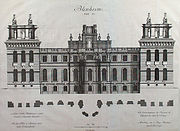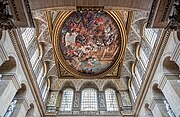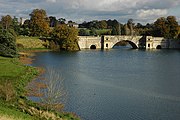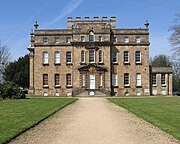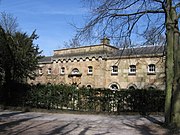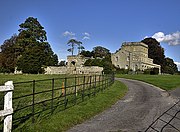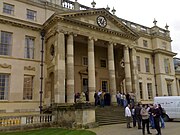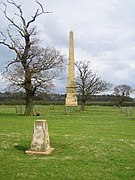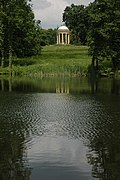- Castle Howard, north front
- Castle Howard, north front
- Castle Howard, south front
- Castle Howard, south front
- Great Hall, Castle Howard
- Antique Passage, Castle Howard
- Great Obelisk, Castle Howard
- The Temple of Four Winds, Castle Howard
- Pyramid Gate, Castle Howard
- Blenheim Palace, north front
- North portico, Blenheim Palace
- Blenheim Palace, from the south-west
- Blenheim Palace, view north along the chapel colonnade
- Entrance to Kitchen court, Blenheim Palace
- Kitchen court, Blenheim Palace
- South front, Blenheim Palace
- North front, Blenheim Palace
- East front, Blenheim Palace
- Plan of Blenheim Palace, the colonnade enclosing the courtyard was never built
- Great Hall, Blenheim Palace
- Saloon, Blenheim Palace
- Grand Bridge, Blenheim Palace
- Kimbolton Castle
- Seaton Delaval Hall, north front
- Seaton Delaval Hall, north front
- East wing, Seaton Delaval Hall
- Seaton Delaval Hall, from the south-west
- Seaton Delaval Hall, from the south-east
- Great Hall, Seaton Delaval Hall
- Stables, Seaton Delaval Hall
- Belvedere, Claremont
- South front, Kings Weston House
- East front, Kings Weston House
- Loggia, Kings Weston House (attributed to Vanbrugh)
- The Brewhouse, Kings Weston House (attributed to Vanbrugh)
- Grimsthorpe Castle, from the north
- Grimsthorpe Castle, detail of the north front
- Eastbury House, Doset, the surviving kitchen wing
- Lumley Castle
- Vanburgh Castle, Greenwich
- North portico, Stowe House
- Western Lake Pavilion, Stowe
- Wolfe Obelisk, Stowe
- Rotunda, Stowe
- Morpeth Town Hall, Northumberland
- Robin Hood's Well, Yorkshire
- Ordnance Board Building, Woolwich Arsenal, London (attributed to Vanbrugh)
- Chatham Dockyard gateway (possibly by Vanbrugh)
- Newcastle Pew, St. George's Church Esher
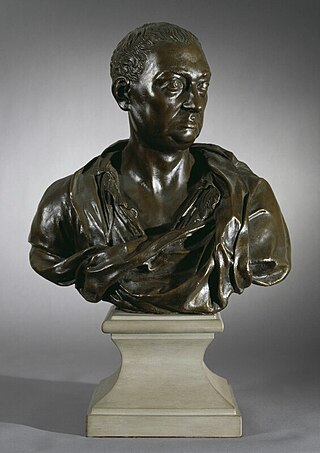
Nicholas Hawksmoor was an English architect. He was a leading figure of the English Baroque style of architecture in the late-seventeenth and early-eighteenth centuries. Hawksmoor worked alongside the principal architects of the time, Christopher Wren and John Vanbrugh, and contributed to the design of some of the most notable buildings of the period, including St Paul's Cathedral, Wren's City of London churches, Greenwich Hospital, Blenheim Palace and Castle Howard. Part of his work has been correctly attributed to him only relatively recently, and his influence has reached several poets and authors of the twentieth century.

Castle Howard is a stately home in North Yorkshire, England, within the civil parish of Henderskelfe, located 15 miles (24 km) north of York. It is a private residence and has been the home of the Carlisle branch of the Howard family for more than 300 years. Castle Howard is not a fortified structure, but the term "castle" is sometimes used in the name of an English country house that was built on the site of a former castle.
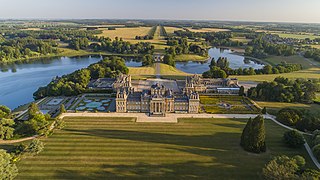
Blenheim Palace is a country house in Woodstock, Oxfordshire, England. It is the seat of the Dukes of Marlborough and the only non-royal, non-episcopal country house in England to hold the title of palace. The palace, one of England's largest houses, was built between 1705 and 1722, and designated a UNESCO World Heritage Site in 1987.

Sir John Vanbrugh was an English architect, dramatist and herald, perhaps best known as the designer of Blenheim Palace and Castle Howard. He wrote two argumentative and outspoken Restoration comedies, The Relapse (1696) and The Provoked Wife (1697), which have become enduring stage favourites but originally occasioned much controversy. He was knighted in 1714.

Seaton Delaval Hall is a Grade I listed country house in Northumberland, England, near the coast just north of Newcastle upon Tyne. Located between Seaton Sluice and Seaton Delaval, it was designed by Sir John Vanbrugh in 1718 for Admiral George Delaval; it is now owned by the National Trust.

Easton Neston is a large grade I listed country house in the parish of Easton Neston near Towcester in Northamptonshire, England. It was built by William Fermor, 1st Baron Leominster (1648–1711), in the Baroque style to the design of the architect Nicholas Hawksmoor.

James Gibbs was one of Britain's most influential architects. Born in Aberdeen, he trained as an architect in Rome, and practised mainly in England. He is an important figure whose work spanned the transition between English Baroque architecture and Georgian architecture heavily influenced by Andrea Palladio. Among his most important works are St Martin-in-the-Fields, the cylindrical, domed Radcliffe Camera at Oxford University, and the Senate House at Cambridge University.

Grimsthorpe Castle is a country house in Lincolnshire, England 4 miles (6.4 km) north-west of Bourne on the A151. It lies within a 3,000 acre (12 km2) park of rolling pastures, lakes, and woodland landscaped by Capability Brown. While Grimsthorpe is not a castle in the strict sense of the word, its character is massive and martial – the towers and outlying pavilions recalling the bastions of a great fortress in classical dress. Grimsthorpe has been the home of the de Eresby family since 1516. The present occupant is Jane Heathcote-Drummond-Willoughby, 28th Baroness Willoughby de Eresby, granddaughter of Nancy Astor, who died at Grimsthorpe in 1964.

William Talman (1650–1719) was an English architect and landscape designer.

Delaval is the surname of a family of gentry/aristocracy in Northumberland, England, from the 11th century to the 19th century. Their main estate was the manor of Seaton Delaval. The 18th century Delavals are noteworthy for their colourful lifestyle, for the magnificent Seaton Delaval Hall and for the development of the little seaport of Seaton Sluice and a coal mine at Old Hartley.

Seaton Sluice is a village in Northumberland. It lies on the coast at the mouth of the Seaton Burn, midway between Whitley Bay and Blyth. In the 2021 census the village had a population of 2,956.
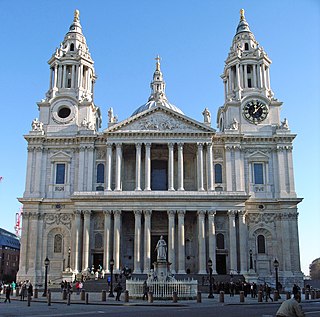
English Baroque is a term used to refer to modes of English architecture that paralleled Baroque architecture in continental Europe between the Great Fire of London (1666) and roughly 1720, when the flamboyant and dramatic qualities of Baroque art were abandoned in favour of the more chaste, rule-based neo-classical forms espoused by the proponents of Palladianism.

John Hussey Delaval, 1st Baron Delaval, known as Sir John Delaval, Bt, between 1761 and 1783, was an English landowner and politician.

Kings Weston House is a historic building in Kings Weston Lane, Kingsweston, Bristol, England. Built during the early 18th century, it was remodelled several times, the most recent in the mid-19th century. The building was owned by several generations of the Southwell family. By World War I, the house was used as a hospital and then later used as a school by the Bath University School of Architecture. The building is today used as a conference and wedding venue, as well as a communal residence.

Vice-Admiral George Delaval, of Seaton Delaval, Northumberland, was a Royal Navy officer, diplomat and Whig politician who sat in the House of Commons from 1715 to 1723.

John Nost was a Flemish sculptor who worked in England in the late 17th and early 18th centuries.

Roger Morris was an English architect whose connection with Colen Campbell brought him to the attention of Henry Herbert, 9th Earl of Pembroke, with whom Morris collaborated on a long series of projects.
William Etty was an English architect and craftsman, best known for designing Holy Trinity Church, Leeds and (probably) Holy Trinity Church, Sunderland.

Vanbrugh Castle is a house designed and built by John Vanbrugh for his own family, located on Maze Hill on the eastern edge of Greenwich Park in London, to the north of Blackheath, with views to the west past the Old Royal Naval College at Greenwich down to the Thames reaching as far as the Houses of Parliament.

Goose-Pie House was a small English Baroque house built by John Vanbrugh in Whitehall, London, in 1701. The house was demolished in 1898. The site now lies under the southeast corner of the Old War Office Building on Whitehall, near the Gurkha Memorial statue on Horse Guards Avenue.
















